Venting your portable air conditioner (AC) is important because it removes moisture from the air that is created during the process of cooling down your space.
If you don’t vent the portable AC unit, the moisture will continue to build up and neutralize the cooling effect, making your unit ineffective.
The less humidity there is in a room, the cooler it feels.
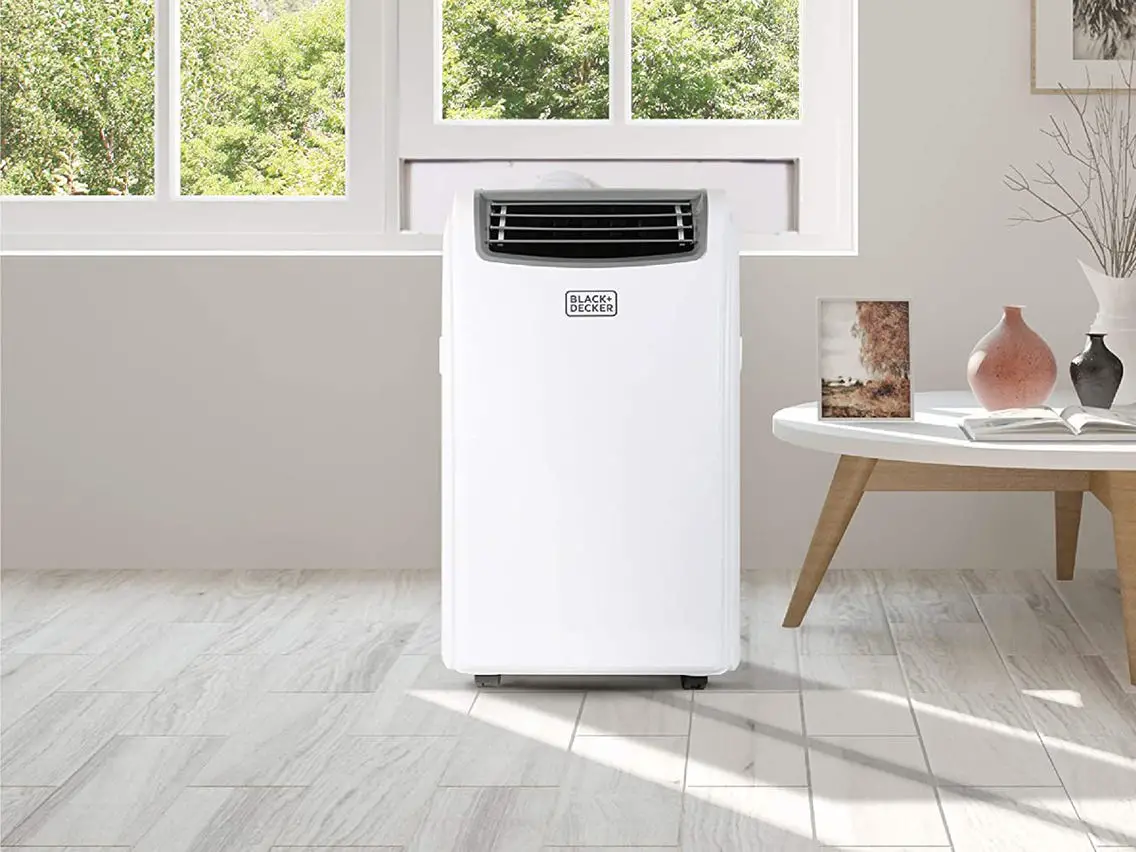
Portable Air Conditioner Venting Options
You can never run out of ways to vent your portable AC. In this article, we will be exploring different venting options that you might find useful and never knew were possible.
|
Venting Option |
Best For |
|---|---|
|
Window Venting |
Window venting is the most commonly used type of AC venting.It is the easiest to install and remove. You can store it somewhere else when you do not need it. This makes it great for home and office use. |
|
Casement Window Venting |
This is a method mostly used by people who do not have traditional windows, especially on upper floors.Casement windows on their own provide good ventilation but are also a good ventilation option for your unit. Due to casement windows almost always being on upper floors, they do not compromise security once used as an AC venting system. |
|
Sliding Door Venting |
There are kits specifically built for sliding door venting. This makes the installation process easy.Sliding door venting accommodates almost every AC unit and is very easy to use. |
|
Through the Wall Venting |
Wall venting is a permanent solution to venting your AC unit.You also do not have to worry about home security because wall venting involves drilling a hole from one room in the house to another. |
|
Drop Ceiling Venting |
Drop ceiling venting is commonly used in computer rooms.It is perfect for homeowners who have a large ceiling space with perfect air exchange. |
Window Venting
Window venting is connecting your AC exhaust hose to a venting kit that leads through the window. The unit is set up relatively close to a window and then connected to an installed window kit.
This way, the air from the exhaust hose can vent out of the room, keeping the use of your AC highly effective. Warm air is sealed from coming inside the room, and cold air is sealed from going out. This has been the standard system of venting out ACs and is highly effective with the use of a perfect window kit.
Advantages
- The installation of a window kit is relatively easy and can be done by anyone, making window venting the most commonly used system.
- A variety of window kits for different AC exhaust hoses are easy to find. Some window kits also accommodate the different sizes and shapes of windows.
- With window venting, most window kits are easy to remove whenever they are not needed, saving space.
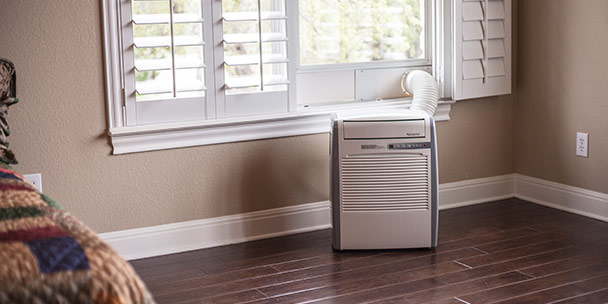
Disadvantages
- Window venting compromises home security as it draws in burglars and creates easy access for people to enter from the outside through the window.
- Placement restrictions are something to consider as your window kit needs to be installed to a unit that is plugged close to the window.
- Only traditional window venting kits come with an AC unit when purchased. If you do not have regular windows, you will have to search for a venting kit that will accommodate your windows.
Best For
It’s the most used venting system due to it being affordable and convenient. Window venting is best for people who want a mobile-friendly venting system and people who don’t have enough space.
Most window kits are easy to install and remove. They can be used in different rooms, on different window sizes and shapes (depends on the specific window kit), and even on recreational vehicles.
They are usually portable and can save space because they can be removed and stored when they aren’t needed. They are ideal for office use and home use.
Casement Window
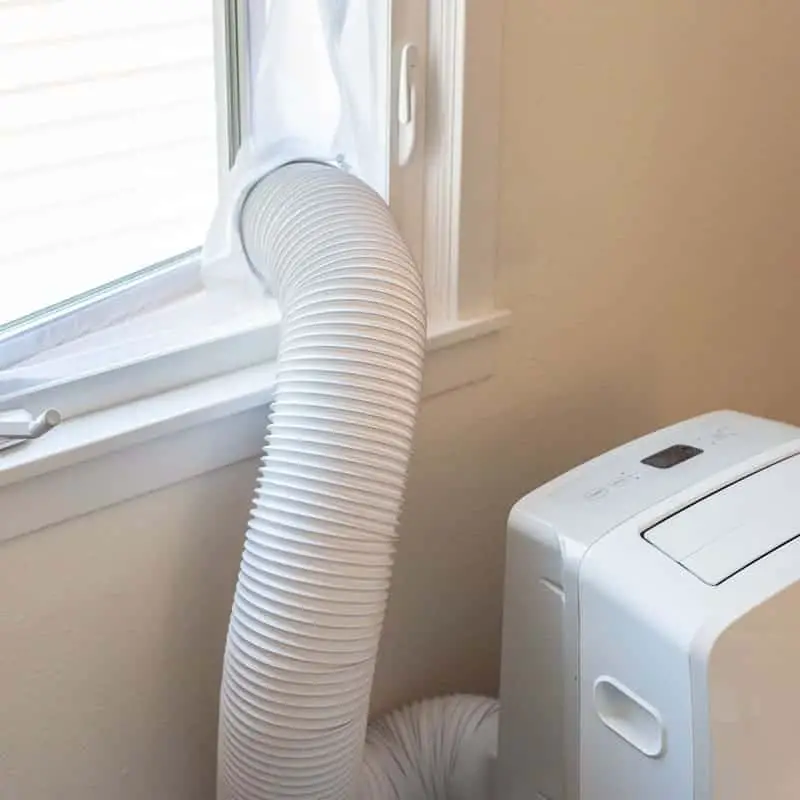
Casement windows are windows that open on hinges and then crank outwards instead of sliding on a window sash. They are more energy-efficient and more soundproof than a sliding door.
With casement windows, normal standard window kits don’t work due to the difference between them and traditional windows. You could fabricate an insert, preferably plexiglass, and create a hole the exact size of your exhaust hose. Adding a sealant also helps ensure the prevention of any air exchange.
Advantages
- Since most casement windows are on upper-level floors, home security isn’t compromised.
- You can also save on space as your venting kit sits by the window and doesn’t take up much room.
- Casement window venting is as effective as traditional window venting.
Disadvantages
- The process of fabricating a plexiglass insert is not easy, and you might need to seek help to cut properly sized holes.
- If you change AC units, you will have to fabricate another insert if the diameter of your exhaust hose is not the same.
- You won’t be able to use the window that your hose slides through.
To the air, condensation and humidity are added. These ACs are effective in dry climates but less effective in humid areas.
Best For
Casement window venting is the best option for people with no access to regular windows. Because most casement windows are on upper-level floors, home security isn’t compromised. Burglars can’t use it as an entry space and probably won’t try to steal your venting kit or your portable AC unit.
There is no use of internal space as the venting kit is placed at the window. Properly installed, casement window venting won’t allow any entrance of insects, air, or dust.

Sliding Door Venting
There are kits built specifically for venting your portable AC through a sliding door. They’re easy to use and can usually accommodate any unit.
To successfully vent your air conditioning unit through a sliding door, you might have to consider having a longer exhaust hose or exhaust hose connector than the ones you might use on traditional windows.
Find a weatherproof sealant to make sure that there is no exchange of air or moisture from the outside to the inside and vice versa.
Advantages
- Sliding door venting kits are easy to find.
- The installation process is easy, and the sliding door venting kits are easy to use.
- Sliding door venting kits usually accommodate almost all types of AC units.
Disadvantages
- You might have to use a security bar as the sliding doors won’t close to the lock. The security bar will stop the pushback from the outside.
- You can’t use the sliding door as a regular door.
- Keep in mind that you might not like seeing the hose through your sliding door if it’s your main door and is visible to anyone.
Best For
Sliding door venting accommodates AC units of almost every type. Venting kits are easy to find, and most of them come ready to install, which makes your installation process easy.
If you can’t vent outside your window, sliding door venting is as effective as window venting. It’s hassle-free.
Through-the-Wall Venting
Wall venting is usually done by homeowners who aren’t able to vent out their ACs through the window. Wall venting provides a permanent solution to your portable AC venting system.

Wall venting involves drilling a hole through your wall to extend your exhaust hose vent to the other room. Usually, it’s the laundry room or storage room. Drilling a hole through the wall will require the right tools. The size of the hole will depend on the size of your exhaust hose’s diameter. This system is usually used in computer and storage rooms.
Advantages
- Wall venting is a permanent solution to venting your portable AC unit.
- Home security isn’t compromised as the vent leads to a room inside the house and not outside.
- You can easily accommodate almost any type of AC unit.
Disadvantages
- Once an error is done in drilling the size of your exhaust hose, it will be hard to fix.
- If you ever consider changing your AC unit, you’ll need one that has the same exhaust hose size so that it fits perfectly in the same hole.
- Wall venting is not an option for people who live in small apartments or rentals.
Best For
Although wall venting is difficult without the right tools, it’s an effective venting system. It’s best for people with enough room and people who are homeowners. Small places might cause the warm air to accumulate and circle back to the cool space. Wall venting is also a permanent solution to venting your AC.
Drop Ceiling Venting
If you have a drop ceiling, you might consider using it as a venting option for your AC.
You would need to create a hole through the ceiling panels. To perfectly accommodate your unit, the hole needs to be the exact size of your exhaust hose diameter.
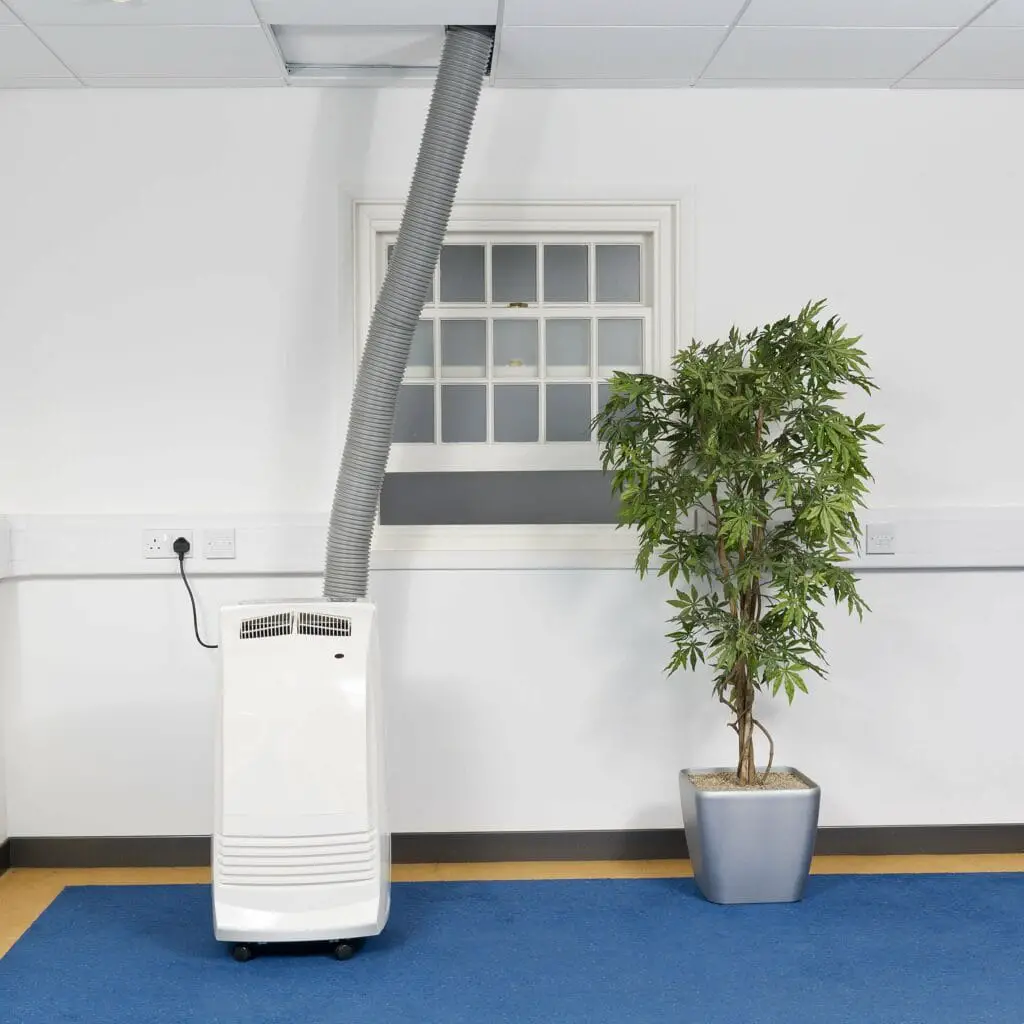
You also have to ensure that you don’t cause a disturbance with electric wires and pipes running through the room ceiling. The ceiling space will have to be monitored so it won’t reach high levels of humidity and warm temperatures that would lead to rot.
Advantages
- This system doesn’t take up any wall or floor space.
- The vents are directly installed from the ceiling, which means there isn’t a need to snake duct tape through the walls.
- There is efficient distribution of cool air, with no fear of insects escaping through gaps.
Disadvantages
- Drop ceiling venting has a high chance of creating mold on the ceiling due to high humidity and warm temperatures.
- Technical knowledge is needed to be able to properly fit the exhaust to the ceiling tile, which makes it a bit hard for most homeowners.
- Keep in mind that some people consider drop ceiling venting to be unattractive.
Best For
Drop ceiling venting is commonly used in computer rooms and storage rooms because they have no access to windows. It’s best for homeowners with a lot of ceiling space. Air will be able to circulate properly, and humidity won’t cause moss.
Factors to Consider When Choosing a Venting Option for a Portable AC
When getting a portable AC, be sure to consider the following:
Placement
For window venting, there should be enough distance to plug in your AC and enough distance for your exhaust to slide through the window kit. Window size and shape are considered when looking for the perfect window kit.

For wall venting and drop ceiling venting, you will need to have enough room and ceiling space. If placed in the wrong place, there might be long-term issues, such as the ineffectiveness of your AC unit and decomposition in the venting room.
The Diameter Size of Your Exhaust Hose
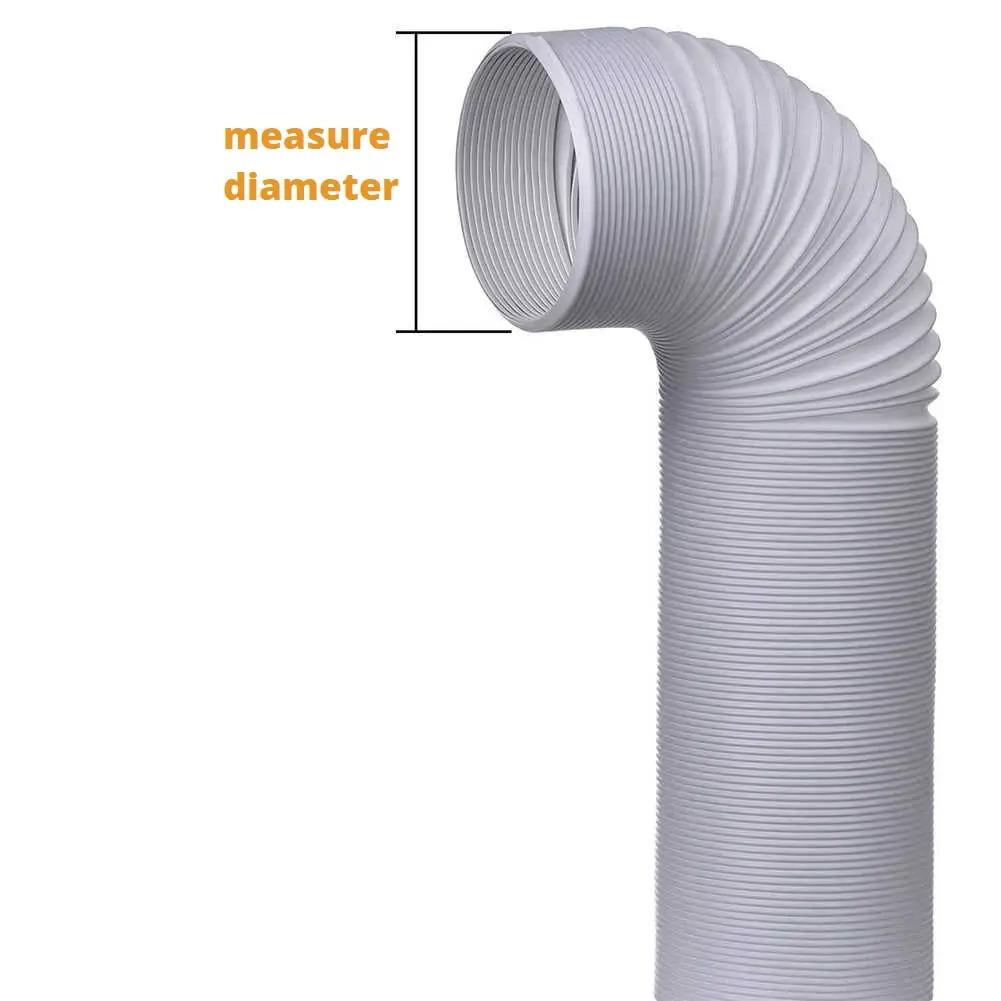
The diameter size of your exhaust hose is the most important aspect to consider before buying a venting kit. If ever you decide on buying a venting kit, it should be suitable for your exhaust hose size.
If the hole is any bigger than the size of the exhaust hose, the use of your AC will be inefficient. The use of an AC unit is to cool down a room. If the gaps allow the exchange of air through the venting hole, the cooling effect of the AC will be neutralized.
Easy to install venting kits have a precise hole size or can be adjusted. DIY venting systems need to be done well with precise measurements.
Availability of Desired Venting Kit
When deciding what venting option to use, you will need to know what venting kit you might need and if it’s available to you. Some venting kits will require you to fabricate them, and that might require professional help.
How to Vent Your Portable Air Conditioner Without a Window
There are various ways to vent out your portable AC without using a window. The process of venting an AC without a window can be tricky and sometimes demands technical knowledge and help.
An alternative usually used in storage rooms and computer rooms is wall venting due to their limited access to windows. Once done properly, wall venting is an effective and permanent solution for venting your portable AC.
Although it might require some skill to bore the exhaust hose hole, it’s worth it. Most households have their exhaust hole vent through the laundry room or storage room.
Wall venting isn’t a suitable venting option if you do not have enough space and are living in a rental.
You can watch this YouTube video. It might help you understand better.
How to Vent Your Portable Air Conditioner With Crank Out Windows
The majority of AC units arrive with traditional window venting kits, which don’t work for casement windows. For your part, you will have to DIY the window and install the kit in a different way than you would have for a regular window.
The main glass can be substituted with a plexiglass insert. You can then drill a hole in the plexiglass that will be the same size as your exhaust hose. After installing the fabricated window, you slide the hose through the hole and seal off the edges with a sealant for the perfect measurement. It’s not a complicated process and is as effective as window venting.
The only disadvantage would have to be when you change your AC, and you get a new hose with a different diameter size. You might have to redo your plexiglass again.
This YouTube video might help:
How to Vent Your Portable Air Conditioner Through a Patio Door
Sliding doors have ready-to-install venting kits to make the sliding door venting process easy.
All you will need is your kit and a long exhaust that will be long enough to slide the exhaust hose through. A hole will need to be cut through the sliding door, the exact size of your exhaust hose diameter.
You might also need a security bar to stop the door from being the outside push. It might not lock once the kit is installed.
Check out the following video. You might find it useful:
How to Vent a Portable Air Conditioner Through the Ceiling
Venting your AC unit through a ceiling involves reconfiguring or adding a drop ceiling or a panel ceiling into the ventilation zone. There are ceiling kits available to make the installation process easy. You cut a hole through the ceiling panel to accommodate the size of your AC unit exhaust hose.
Before doing a ceiling vent system, you might want to consider the size of your ceiling space. If there isn’t enough air circulation, the humidity and warm air released might cause moss to grow in the space. This could potentially cause long-term problems.
The following YouTube video might help you:
Conclusion
In conclusion, you will never run out of ways to vent your portable AC. All you need to do is decide which one suits your situation and how it’s installed.
People Also Ask
Below are some common questions surrounding this topic.
To cool down your space, portable ACs need to be installed properly and transfer hot air as they cool. They release this hot air through an exhaust pipe.
The majority of ACs come with a venting kit that you install in your window. But not everyone has a traditional window to vent out their AC unit. There are other alternatives such as wall venting, sliding door venting, casement window venting, and drop ceiling venting.
Portable ACs release warm air that needs to be vented out of the room. If you don’t vent out your portable AC, moisture builds up and neutralizes the cooling effect of the unit. The purpose of your AC is to cool down a room. Without ventilation, your AC will not be effective.
The unit will end up running the air in the room in an endless cycle between humid and hot. Eventually, the room will be heated up more than it should cool off.
The standard exhaust hose length is 4 to 7 feet, but generally, the hoses vary by length. They are made from strong and temperature-resistant plastic and are reinforced with metal. If need be, the hose can be extended.
The recommendation is the hose should not be extended longer than 9 feet. Long hoses should be avoided because they have chances of being bent. The shorter the hose, the straighter it is. The flow of the hose should not be disturbed or tampered with.
Venting kits are almost always included when you purchase your portable AC. For window venting, it’s complimentary to get your venting kit upon unit purchase. If there’s ever a need to get a venting kit, a variety of kits are available for any venting system chosen by you.
Almost all portable ACs need to be vented, but there are exceptions. There are evaporation air coolers that offer a ventless AC choice. They don’t have a hose, and they deliver cold air to your home by evaporating water.
